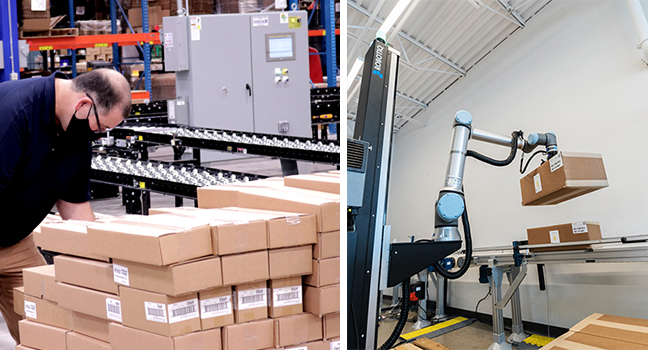Automation: Starting with a Clean Slate
First, re-engineer the process—then automate it to maximize effectiveness

How should your next automation project be evaluated? In many cases, companies try to replicate a manual processes through automation: if a person once rotated a tote, then picked from it and placed the contents into a container, that’s what the automation does. This kind of solution can provide excellent results, but may not be the optimal solution. What if you began with operational goals in mind that imagine a solution without the manual process?
Automated systems—particularly material handling systems in the manufacturing and warehousing space—are successful when they zero in on successful processes. If executed with forethought and comprehensive understanding of operational needs, automation can be extremely powerful. As anyone who runs a warehousing facility can tell you, this level of automation is becoming increasingly necessary as labor pools contract and needs expand.
But if you automate a flawed process, all you’re doing is operating inefficiently but faster.
Start with a blank sheet of paper—not a preconceived concept based on the way it’s always been done.
Evaluating with fresh eyes
 Automation evaluation criteria that focuses on streamlining existing, manual tasks performed by workers rather than looking at the entire sequence with fresh eyes and a willingness to fully redesign the process is less efficient than a new sequence that can be executed through automation. It should be obvious that when you remove people from a task, that two things happen:
Automation evaluation criteria that focuses on streamlining existing, manual tasks performed by workers rather than looking at the entire sequence with fresh eyes and a willingness to fully redesign the process is less efficient than a new sequence that can be executed through automation. It should be obvious that when you remove people from a task, that two things happen:
- You remove the physical limitations of humans
- You remove the flexibility and adaptability of humans.
Design your processes with both these things in mind.
A person may not be as fast as a picking robot, but is more likely to make good decisions in the event of a variable situations, for instance. People cannot compete with the speed and precision of automated systems for repeatable events, but are adept at making decisions when a process can’t be defined narrowly. When you come at the project from this angle, you can analyze the task, whatever it is, with new eyes.
Factors to consider
Automation can go places and do things people can’t.
If people are in the zone, you must bake in significant safety buffers. As we’ve written before, ergonomics is a primary design consideration for efficient operations. If your systems are built so that only maintenance must interface with automation equipment regularly, you can specify different types of automation and space utilization.
Can you fully remove people from the process? Do you trust that the system won’t go offline?
Many automated systems allow companies to fall back on manual processes in case of downtime.
Above: panel discussion focus on redundancy for automated systems.
This is understandable, but it also reduces the effectiveness of the automated solution. While having that manual redundancy is smart, it’s also a limitation that will alter the solution and could reduce its impact.
Rather than building in expensive and limiting manual fallback systems, consider adding robust spare parts inventories, contracts with repair experts, and internal expertise that can quickly restore the system rather than building in manual backups that hinder the results. Proven and reliable automated should be capable of supporting your operation without backwards-compatible manual backup systems.
What metrics are you chasing?
Most automation decisions undergo ROI analysis, which is a smart way to go about it. Design your process around finding the best, most balanced solution for your business needs. That may or may not result in deciding to automate. Chasing justification isn’t the same as chasing overall impact.
What is the goal of the automated system? Is it to operate faster? To increase productivity? To produce better customer outcomes? The answer to this question can be one, all or most of these.
Automate the right parts of the process
ROI calculations frequently focus on labor—usually reducing it at the point of use—which is a valid method, but not a completely accurate one. You should also know whether or not your solution increases labor elsewhere in the process. Does the solution alter the work process by removing or re-tasking that labor to more important areas? Does it allow you to completely alter the flow of the process and the goods in it?
It’s important to consider all these factors without bias toward your previous solution when it comes automated systems evaluation.
Read more
- How Material Handling and Automation Increases Labor Flexibility
- New Rules for Industrial Automation ROI
- Warehouse Automation Risks to Avoid
Tags: ROI, Process Management
Scott Stone is Cisco-Eagle's Vice President of Marketing with 35 years of experience in material handling, warehousing and industrial operations. His work is published in multiple industry journals an websites on a variety of warehousing topics. He writes about automation, warehousing, safety, manufacturing and other areas of concern for industrial operations and those who operate them.



